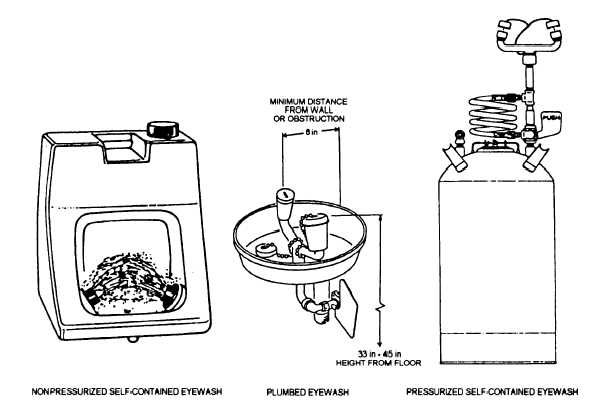| |
Figure 5-6.—Emergency eyewash stations.
Emergency Eyewash Stations
Emergency eyewash facilities are designed to
provide first aid to personnel who splash corrosive
materials into their eyes. Corrosive materials are espe-
cially hazardous to the eyes because the longer the
materials contact the eyes, the more damage they cause.
If you get a chip of metal in your eye, as long as you
don’t rub your eye, the metal doesn’t cause further
damage. You have time to get to sick bay to have the
eye treated. Chemicals continue to cause damage as long
as they remain in the eyes. Taking the time to go to sick
bay for treatment could result in serious damage to the
eyes. For that reason we need on the spot first aid to wash
the eye to dilute the chemical.
Areas in which corrosive materials are used must
have emergency eyewash facilities. Make sure all such
emergency facilities are easily accessible to personnel
in need of them. Make sure the locations of all units are
unobstructed and are located as close to the hazard as
possible. In no instance should a person have to travel
more than 100 feet or take more than 10 seconds to get
to the eyewash unit. People who work in areas that use
great quantities of corrosives face the risk of splashing
the materials on their body. Those areas must be
equipped with a combination deluge shower and
eyewash station.
Plumbed and self-contained emergency eyewash
equipment (fig. 5-6) flush the eyes using potable water.
The minimum flow rate must be 0.4 gallons per minute
for 15 continuous minutes. Ensure the velocity of the
water will not hurt the user’s eyes.
You must clearly mark each eyewash station with a
safety instruction sign. Post signs in a visible location
close to the eyewash unit. The sign must identify the unit
as an emergency eyewash station.
ASBESTOS CONTROL PROGRAM
For many years, the Navy used asbestos as the
primary insulation (lagging) material in high-
temperature machinery, shipboard boilers, and the
piping of boiler plants at shore facilities. The material
was used as floor tile, as gasket materials, and for other
uses that required fire resistance. We now recognize
airborne asbestos fibers as a major health hazard.
The Navy developed an asbestos exposure control
program to protect and monitor personnel who have
been exposed to asbestos. Aboard ship, many pipes and
boilers still have asbestos insulation. However, the Navy
started a program in the mid- 1970s to use less harmful
materials, such as fibrous glass, for pipe and boiler
insulation.
5-15
|

